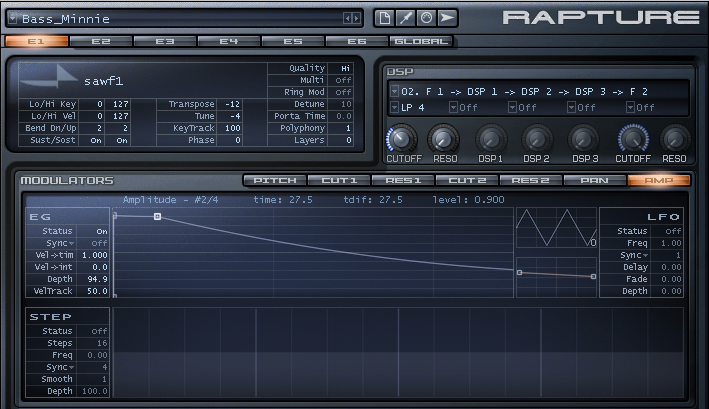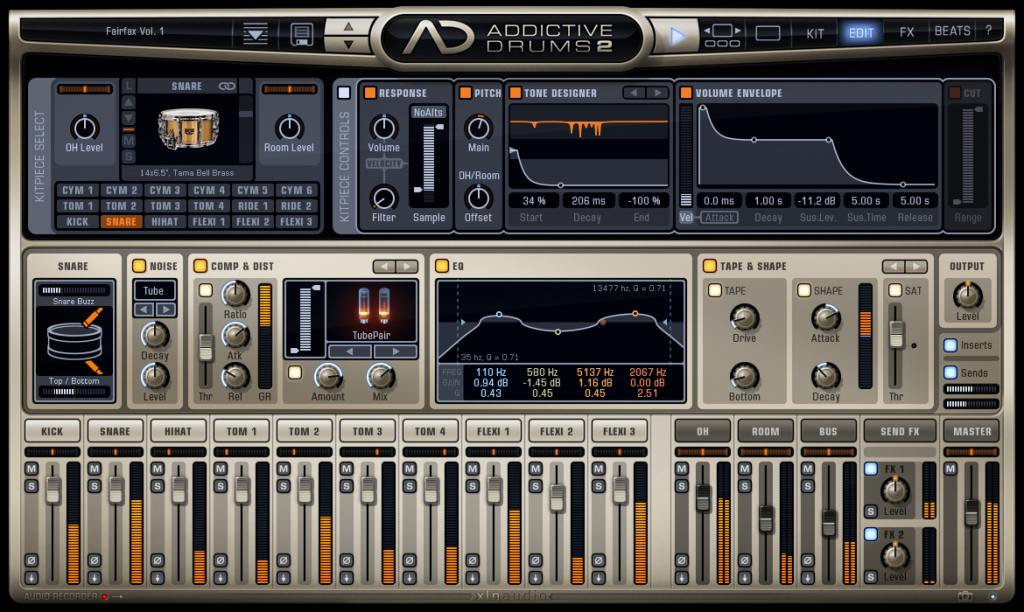Z3TA+ 2’s powerful synth engine is capable of creating all kinds of different sounds. Creating your own EDM Kick Drum is a great way to learn how a synthesizer works – especially when it comes to routing. Check out this free video tutorial on creating your own custom kick drum in Z3tA+ 2.
Feature Spotlight: Addictive Drums 2 (Now in SONAR X3 Producer)
In this video we review some of the great new features inside of Addictive Drums 2. SONAR X3 Producer now includes a free upgrade to Addictive Drums 2.
- New sound shaping and kit building features
- More legendary drums. New sound engine
- New rhythm creation and transformation tools.
- More kitpiece slots,
- New studio-grade effects (including delay and saturation/distortion),
- Brand new Tone Designer and Transient Shaper modules,
- Easy kitpiece linking, and new electronic sounds that can take your drums to exciting new territories
- Drag-and-drop drum hits and complete loops straight to your music software’s timeline for maximum ease of use.
- Say goodbye to boring beats. Our new Beats page helps you locate or build interesting beats quickly and to transform existing beats to make them uniquely yours.
The “Punch” Factor with Synthesizers
What exactly constitutes “punch”? Find out here
by Craig Anderton
We all know a punchy recorded sound when we hear it—but what exactly constitutes “punch”? It seems that perhaps punch is something that can not only be defined, but quantified.
This all started because years ago, I wondered why seemingly every musician agrees that the Minimoog has a punchy sound. Then, when I started playing a Peavey DPM3, several people commented that my bass patches had a punchy sound, “like a Minimoog.” Clearly, the technologies are totally different: one was analog, the other digital; one used voltage-controlled oscillators, the other sample playback. Yet to listeners, they both shared some common factor that was perceived as punchiness.
Analyzing a Minimoog bass line revealed something interesting: even with the sustain set to minimum, there was about 20-30 milliseconds where the sound stayed at maximum level before the decay began. There is no way to eliminate that short period of full volume sustain; it’s part of the Minimoog’s characteristic sound.
I then looked at the DPM3’s amplitude envelope and it exhibited the same characteristic—a 20-30 ms, maximum level period of sustain before the decay kicked in. Also, both instruments had virtually instantaneous attacks. Could this combination be the secret of punch?
For comparison, I then checked two synths that nobody considered punchy-sounding: an Oberheim OB-8, which is generally characterized as “warm” and/or “fat” but not punchy, and a Yamaha TG55. Both had fixed attack times, even with the attack control set to zero, that lasted a few milliseconds. I also recalled some experiments ex-Peter Gabriel keyboard player Larry Fast ran in the mid-70s, when he was curious how fast an attack had to be for a sound to be “punchy.” His research indicated that most listeners noticed a perceptible loss of punch with attack times as short as one or two milliseconds.
So it seems the secret of punch is that you need an extremely fast attack time, but you also need a bit of sustain time at maximum level. This sustain isn’t long enough to be perceived as sustain per se; it’s more of a psychoacoustic phenomenon.
Wondering if this same technique worked with other sounds, I took an unprocessed snare drum sound and tried to add punch by normalizing each cycle to the highest level possible for the first 20-30 milliseconds. Comparing the processed and unprocessed sounds left no doubt that the edited version had more punch.
When I designed the Minimoog Expansion Pack for Rapture, I made sure that where appropriate, the envelopes had that characteristic Moog attack (Fig. 1). Note that the second node sustains the sound for 27.5 ms. Rapture’s tight attack time and ability to create “high-resolution” envelopes made it easy to add punch.
 Fig. 1: Adding the “punch” factor to a Rapture Minimoog patch. Continue reading “The “Punch” Factor with Synthesizers”
Fig. 1: Adding the “punch” factor to a Rapture Minimoog patch. Continue reading “The “Punch” Factor with Synthesizers”
Free: Old-School Video Game Presets for Z3TA+ 2
June is Virtual Instrument Month at Cakewalk so we thought we would remind you of these great free presets for Z3TA+2 in case you missed them! Stay tuned to the Cakewalk Blog for Synth tips and other special offers all month long.
The Polybius video game expansion pack is a free set for Z3TA+ 2, inspired by all your favorite old-school video game titles. Includes video game themes, game over themes, boss themes, attack effects, blaster effects, and even some timeless sounds you are sure to recognize. The Polybius expansion pack proves the true power behind Z3TA+ 2’s synth engine and best of all, it’s totally FREE!
Polybius Video Game Sound Pack Info:
- 100 Free 8-bit Inspired Sounds
- Title Themes
- Game Over Themes
- Level Themes
- Blaster Effects
- Run, Jump, Attack Effects
- Classic Sound FX
- Additional MIDI Arpeggios
- Both Simple and Complex Presets
- Great for shaping your own sounds!
How to Download Polybius: If you already purchased Z3TA+ 2, you can download the free Polybius Sound Pack from your My Account page on the Cakewalk Store. If you have not yet created an account, you will need to use the same email address as your Z3TA+ 2 registration. Then proceed to the My Account section and under “My Registered Products” you will see the Free Polybius Expansion Pack for Z3TA+ 2.
If you buy Z3TA+ 2 through the Cakewalk Store then the free Polybius Sound Pack will be included with your Z3TA+ 2 download.
If you purchase Z3TA+ 2 on Steam the Polybius Sound Pack is Free DLC.


